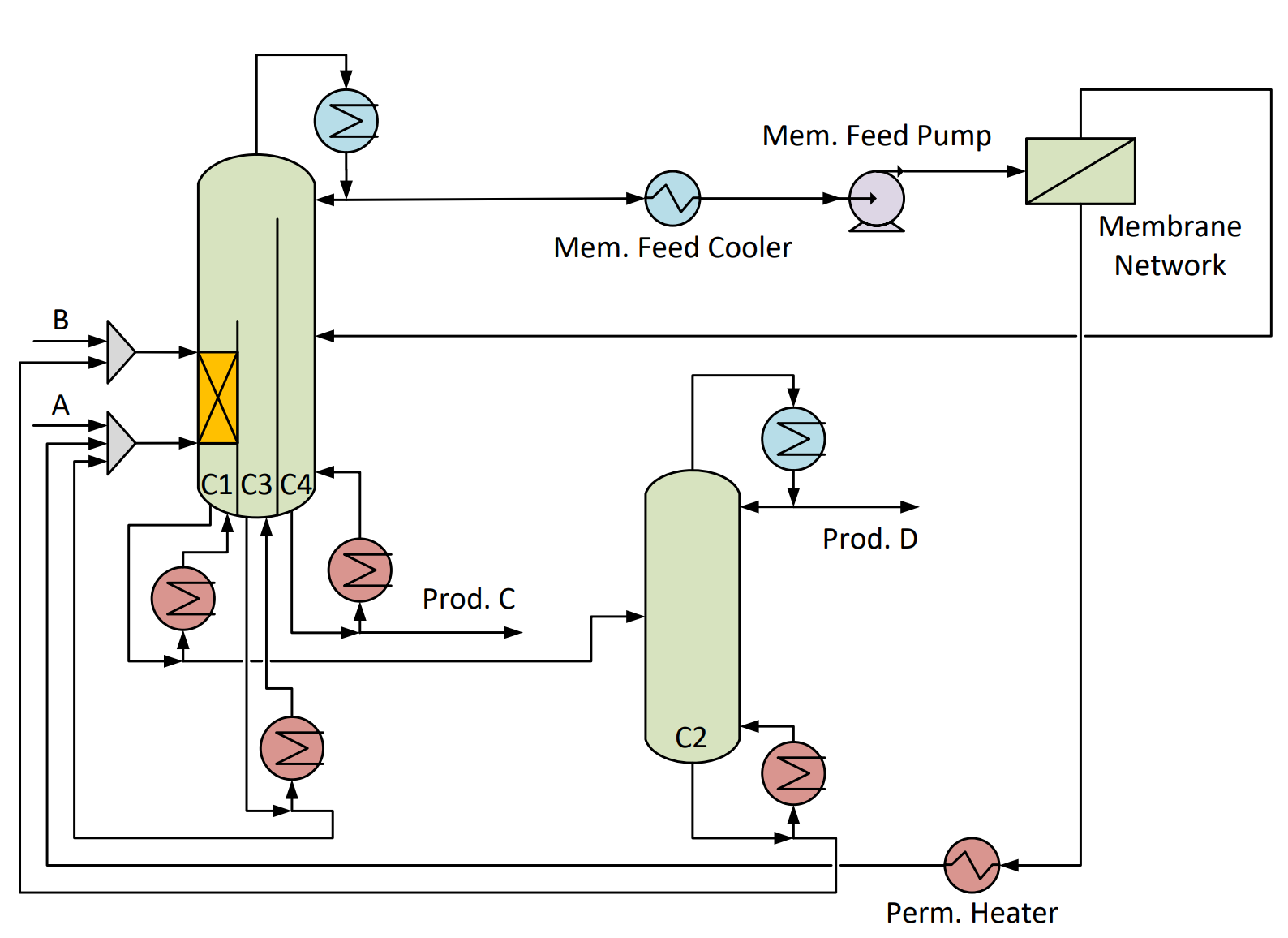The concept of Process Intensification (PI) has received considerable attention over the past few decades as part of an effort to increase the efficiency and economic performance of chemical processes whilst also minimising environmental impact. The main concepts of PI related to separation processes are reactive distillation, hybrid distillation processes, and dividing wall columns. Reactive distillation (RD) is a PI process which integrates the reactive process and the separation process into a single-column shell. The synergistic effects between the two processes offer a significant reduction in energy requirements (i.e., operating cost), and the use of a single-column shell also greatly reduces capital costs. Hybrid distillation is a PI process that integrates at least one distillation process with other separation process(es). One of the most popular examples is the hybrid distillation process with a membrane process, of which pervaporation is the most common membrane type. A hybrid distillation-pervaporation (DP) process is particularly beneficial when it comes to the separation of azeotropic or close-boiling mixtures by exploiting the separation mechanism of the membranes which does not rely on thermodynamic equilibrium. For multi-component, i.e., ternary and quarternary, systems where two or more distillation columns are normally required for the separation, the distillation columns can be integrated into a single column shell in a dividing wall column (DWC). DWCs can offer significant energy savings due to the thermal coupling streams, as well as significant capital cost savings as only one column shell is required. Our team has performed extensive studies on the optimal design and operation of RD processes [1], DP processes [2], and DWC systems [3]. Recently, we have integrated the DP and DWC processes into a hybrid dividing wall column (HDWC), and demonstrated that the HDWC design has great economic potential [4]. This work will incorporate the RD and HDWC designs into an even further intensified process to form a hybrid reactive dividing wall column (HRDWC). The optimal economic potentials of HRDWC will be investigated by comparing HRDWC with conventional azeotropic separation configurations (e.g., pressure swing distillation) for both slow and fast reactions.
Very few studies [5, 6] in the literature have considered hybrid reactive dividing wall columns (HRDWC). For example, Holtbruegge et al. [5] designed an HRDWC with a vapour permeation membrane for a transesterification process and compared the HRDWC with other possible configurations on a cost basis, including that of a reactor followed by pressure swing distillation (base case), RD with pressure swing distillation, reactive dividing wall column (RDWC) with pressure swing distillation, and RD with vapour permeation membrane. The comparison showed that applications with membrane units and/or RDWC could reduce the operating cost significantly. The best design with the lowest Total Annual Cost (TAC) was RDWC followed by pressure swing distillation, rather than the H-RDWC. However, the study was limited to a specific mixture and conditions, and the reactant ratio was fixed at 2:1 (one of the reactants is considered fully reacted).
Therefore, the aim of this work is to make a more comprehensive comparison between HRDWC with other structures by considering a generic reversible reaction () where one of the reactants (A or B) forms a minimum boiling azeotrope with one of the products (C or D) with 1:1 reactant ratio, and both unreacted reactants will be recovered. Six structures will be considered in this work, which are the reactive distillation-pressure swing (RDPS) structure, modification of RDPS into the reactive dividing wall (RDWC-PS), reactive distillation-distillation-pervaporation (RDDP), modification of RDDP into the hybrid reactive dividing wall (HRDWC-DP), reactive distillation-distillation-pervaporation-distillation (RDDPD), and modification of RDDPD into HRDWC-DPD. To study the HRDWC under different reaction conditions, the reaction kinetics will be manipulated to consider both fast and slow reactions. The designs will be optimised simultaneously using a stochastic optimisation method (e.g., genetic algorithm) as outlined in Chia et al. [7], with rigorous process models created within gPROMS Process.
In conclusion, this work will provide a detailed investigation of hybrid reactive dividing wall distillation columns (HRDWC) based on different reaction kinetics. Furthermore, a comprehensive comparison between HRDWC and its more conventional counterparts of several separation processes in series will demonstrate the economic potential of this highly intensified process.
References
[1] Tsatse A, Oudenhoven SRG, ten Kate AJB, Sorensen E. Optimal design and operation of reactive distillation systems based on a superstructure methodology. Chemical Engineering Research and Design. 2021;170:107-33.
[2] Chia DN, Sorensen E. Optimal Design and Operation of Hybrid Distillation/Pervaporation Processes. In: 12th international conference on Distillation & Absorption; 2022.
[3] Duanmu F, Chia DN, Sorensen E. A shortcut design method for complex distillation structures. Chemical Engineering Research and Design. 2022;180:346-68.
[4] Chia DN, Duanmu F, Sorensen E. Optimal Design of Hybrid Dividing Wall Columns for Azeotropic Separations. In: 12th international conference on Distillation & Absorption; 2022.
[5] Holtbruegge J, Kuhlmann H, Lutze P. Process analysis and economic optimization of intensified process alternatives for simultaneous industrial scale production of dimethyl carbonate and propylene glycol. Chemical Engineering Research and Design. 2015;93:411-31.
[6] Wang C, Wang C, Guang C, Gao J, Zhang Z. Hybrid reactive distillation using polyoctylmethylsiloxane membrane for isopentyl acetate production from mixed PVA by products. Journal of Chemical Technology & Biotechnology. 2019;94(2):527-37.
[7] Chia DN, Duanmu F, Sorensen E. Optimal Design of Distillation Columns Using a Combined Optimisation Approach. In: Turkay M, Gani R, editors. 31st European Symposium on Computer Aided Process Engineering. Elsevier B.V.; 2021. p.153-8.


